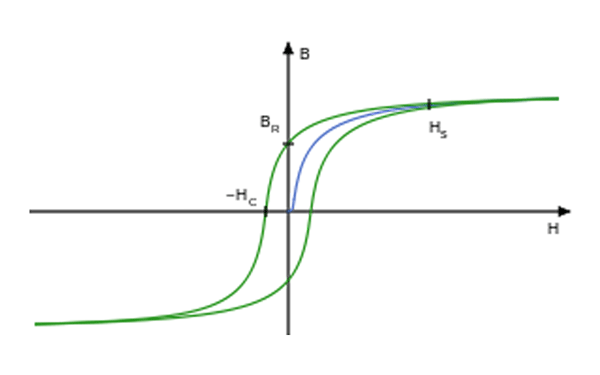Hysteresis curve
A hysteresis curve shows the relationship between the induced flux density -B and the magnetic field strength -H
The hysteresis or BH curve provides insight into the following magnetic properties:
- remanence, Br
- coercivity HcJ and HcB
- energy product BHmax
(De-) magnetization curve - BH curve = hysteresis curve
When a periodically alternating external magnetic field H is applied, the magnetization of a ferromagnetic material follows a magnetization curve. Starting from 'virgin' material without net magnetization, we follow the blue curve the first time we do this (see image below).
Upon reaching the saturation flux density - with magnetic field strength Hs - the magnetization does not increase further.
Remanent field strength BR
If we then invert the field, the magnetization at field strength H = 0 has not fully decreased to zero. There is a remanent field strength BR left as a result of the ‘Weiss domains’ not returning to their original state.
Coercive field strength Hc
Only when the externally applied field strength has reached an oppositely directed value - the coercive field strength Hc - does the magnetization B = 0 and the product is demagnetized. The area of the loop passed through with alternating magnetization is a measure of the loss. Materials with low values of Hc and therefore small hysteresis loops are called soft magnetic materials. If Hc is very large, they are called hard magnetic material.
'Hysteresis' is present in ferromagnetic material. You can also see this in the figure below. The magnetic field strength H is shown along the x-axis and the degree of magnetization (magnetic flux density) B is shown along the y-axis. If there is no magnetic field, there is no magnetization at the beginning and we therefore find ourselves at the origin of the graph.
If we apply a magnetic field, the ferromagnetic material will become magnetic. This continues until all the 'Weiss domains' in the material have the same orientation. The material is now at its maximum magnetization and increasing the magnetic field has no further influence on the degree of magnetization. If we reduce the magnetic field, the Weiss domains will mostly maintain their position.
When the field becomes more negative, the total magnetization also changes direction. This continues until all the spins are oriented in the other direction and the magnetization is reversed. The product is now demagnetized.
See YouTube video: Flux density vs remance
Hysteresis curve (BH curve)

